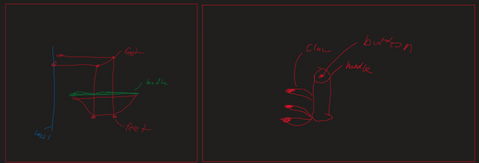MARSHALL BAHEN

Power in the Community
This project was very inspiring for me, as it showed me the resilience and strength demonstrated by people while facing daunting challenges. I was particularly moved by the client’s story and found his challenges very inisghtful to the world around me. I had not considered how difficult common objects are to manipulate for people who have disabilities. This definitely brings a new perspective to my design work and thinking as a whole when facing a problem.
Design Process
I started the design process by sketching a variety of possible ideas to help our client. From the beginning my focus was on ways that I could help him manipulate objects.
After developing my initial sketches I moved on to a 3d CAD modelling stage. I modelled a variety of solutions using our sketches as starting points. Followed by creating a variety of low fidelity prototypes to get a physical sense of my design. I combined the best features and modified the design to be more user friendly.
Through CAD I pursued a variety of design iterations, and eventually came up with a design which would allow the container to be supported while still being removable.


Summary
This project also taught me that there are a wide variety of solutions to a single problem. During one of the client talks he mentioned that “anything you can do would help”. I found this statement particularly moving and it really made me reflect on how I want to apply the skills and knowledge I am developing in order to best serve the community.
Throughout the design process my team focused on helping our client in his day to day life. I wanted to find a solution to the client's problems with pouring tea, which he stated always caused him difficulty and resulted in dropped teapots, spills, and joint dislocations.
I developed a wide variety of ideas to tackle this challenge including a teapot with baffles inside to prevent the tea from sloshing around inside and shifting the center of mass, resulting in excess force on James hands. However this idea was eventually ruled out due to manufacturing and time constraints.
I eventually developed a stand that could be easily assembled and disassembled using using friction fits. The stand could be tilted back and then use notches in the sides to pick up a wide variety of containers.
I settled on this design due to its generalizability and scalability. I envisioned a product that could be used to pour many things such as teapots, milk cartons, bags of flour or sugar, juice containers, pots, and pans.
I am happy with the overall result, and the design satisfied all of our primary objectives.










